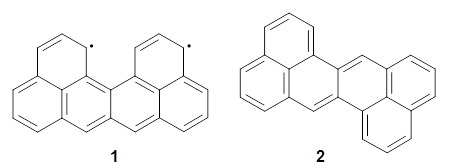Uthrene 1 is the smallest formally diradical fragment of graphene; it cannot be expressed in a closed shell, fully electron-paired Kekule form. Its isomer zethrene 2 on the other hand, can be expressed in closed shell form.

Melle-Franco has examined these, and related, polycyclic aromatic hydrocarbons with DFT.1 The optimized structure of singlet and triplet 1 at CAM-B3LYP/6-31g(d,p) are shown in Figure 1. The singlet-triplet energy gap of 2 is 16.5 kcal mol-1 with a ground state singlet. However, for 1 the triplet is predicted to be lower in energy than the singlet by 7.7 kcal mol-1. And this gap increases to 10.9 kcal mol-1 at CASSCF(14,14)/6-31g(d,p)//CAM-B3LYP/6-31g(d,p). Natural orbital population analysis of the singlet of 1 at CASSCF identifies two orbitals with populations around 1 e.
Interestingly, both the singlet and triplet of 1 are not planar, exhibiting a twist to avoid the clashing of the hydrogens in the bay region. (This twisting is best seen by clicking on the structures in Figure 1, and viewing the molecules interactively through Jmol.)
|
singlet |
triplet |
Figure 1. CAM-B3LYP/6-31g(d,p) optimized geometries of the singlet and triplet of 1.
References
(1) Melle-Franco, M. "Uthrene, a radically new molecule?," Chem. Commun. 2015, 51, 5387-5390, DOI: 10.1039/C5CC01276G.
InChIs
1: InChI=1S/C24H14/c1-5-15-7-3-11-20-22(15)17(9-1)13-19-14-18-10-2-6-16-8-4-12-21(23(16)18)24(19)20/h1-14H
InChIKey=WAKUAPLTIMTENF-UHFFFAOYSA-N
2: InChI=1S/C24H14/c1-5-15-7-3-11-19-22-14-18-10-2-6-16-8-4-12-20(24(16)18)21(22)13-17(9-1)23(15)19/h1-14H
InChIKey=UXUXNGMSDNTZEC-UHFFFAOYSA-N



Henry Rzepa responded on 10 May 2015 at 2:14 am #
These are also known as non-Kekule hydrocarbons. Christopher Longuet-Higgins was one of those who promoted the concept in the 1950, and I do recollect that a number of interesting non-Kekule biradical molecules emerged such as the Schlenk-Brauns hydrocarbons which were first discovered as early as 1930.